Impact of the September 2023 Storm Daniel and Subsequent Flooding in Thessaly (Greece) on the Natural and Built Environment and on Infectious Disease Emergence
Abstract
:1. Introduction
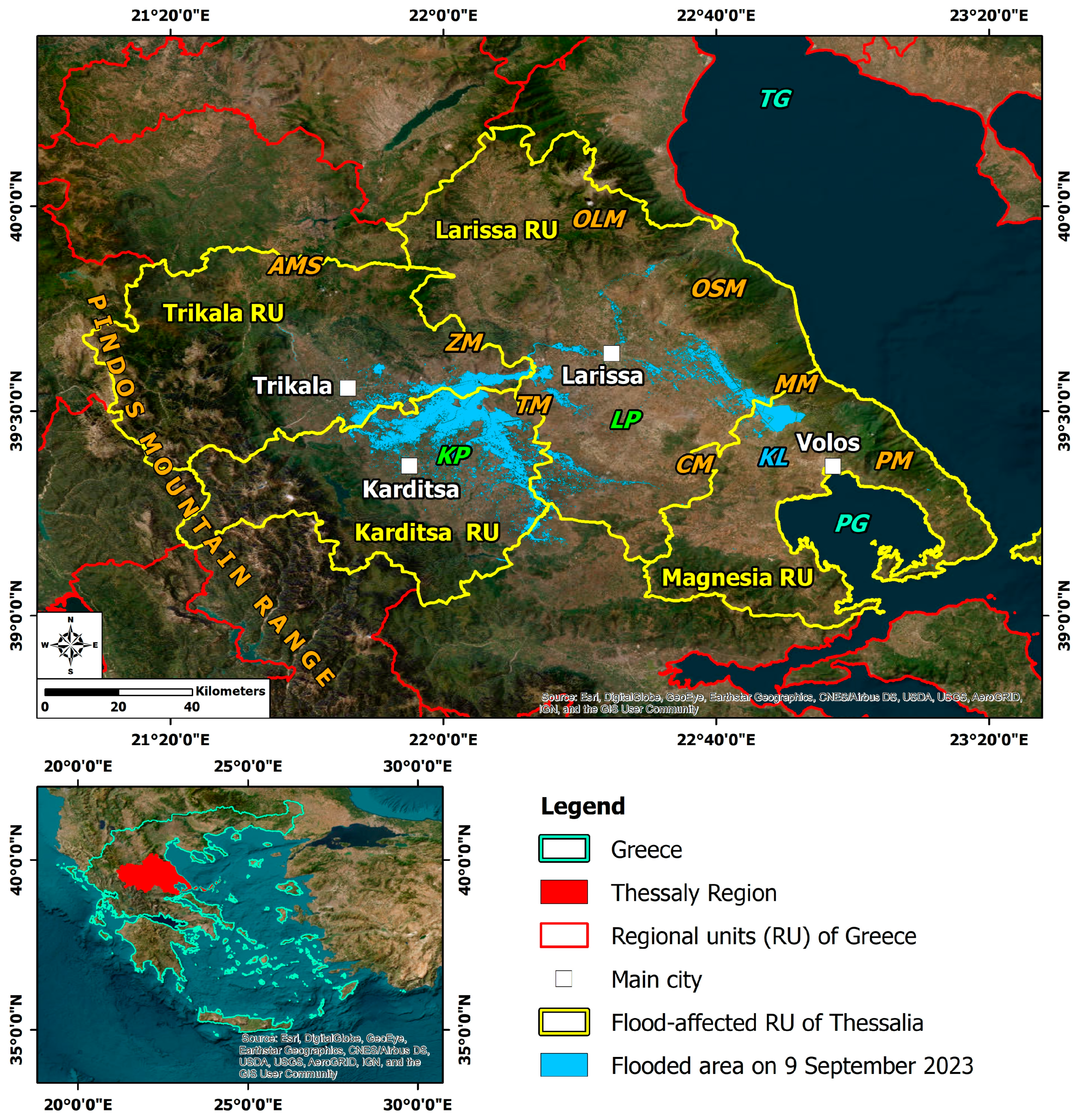
2. Methodology
3. Location and Geological Structure of the Region of Thessaly and Disaster Inventory
4. The Storm Daniel and Its Impact on the Natural and Built Environment
5. Risk Factors for Infectious Diseases Emergence in the Flood-Affected Thessaly and Impact on Public Health
5.1. Rodent-Borne Infectious Diseases
5.2. Vector-Borne Infectious Diseases
- From 18 October to 5 December 2023, no laboratory-confirmed cases of WNV infection were recorded in the affected Region of Thessaly.
- In Mouzaki, Palamas, and Sofades Municipal Units of the Karditsa Regional Unit and in the Farsala Municipal Unit of the Larissa Regional Unit, no new cases of WNV infection were recorded from 30 August to 5 December 2023. As shown by the mapping of the flooded area from the activation of the Copernicus Emergency Management Service [10], the lowland areas of these municipalities, especially the Palamas Municipal Unit, were already flooded on 13 September and remained so for many days later until the beginning of October and the final receding of the event.
- The largest increase in WNV cases was observed in the Larissa and Trikala Municipal Units. It was of the order of 8 and 10 cases, respectively, from 30 August to 17 October 2023. These areas were affected by flooding caused by the overflow of the Pineios and Lithaios Rivers in Larissa and Trikala, respectively.
5.3. Infectious Diseases from Injuries (Tetanus)
5.4. Infectious Diseases Resulting from Water Pollution
- Fuel for heating homes, moving vehicles, and running machinery, such as diesel and gasoline.
- Products with chemically treated materials that were affected by the flood with the subsequent release of hazardous chemical components, such as chromated copper arsenate (CCA) and ammoniacal copper zinc arsenate (ACZA) among others.
- Other harmful materials used daily by residents, such as cleaning agents and insecticides.
- Industrial waste; commercial and household waste including food waste; raw materials; fertilizers; cleaners; insecticides; machinery; equipment; and shop-specific waste and daily waste discharged from the households.
5.5. Public Health Risks Associated with Flood Waste
- The production of asbestos-containing dust during the various phases of waste management;
- The presence of fecally contaminated materials in the waste;
- The creation of injuries and wounds during the management of flood waste;
- The presence of spoiled food as a bacteria breeding ground;
- The presence of food exposed to humidity and inadequate ventilation conditions leading to the growth of mold on food;
- The discharge of treated wood into the environment without prior treatment;
- The burning of treated wood with CCA;
- The leaching of chemicals and heavy metals from wood during flood waste disposal;
- The influx of heavy metals and other chemicals into surrounding surface water bodies;
- The discharge of waste into surrounding surface water bodies;
- The selection of unsuitable sites for waste disposal, especially close to residential areas, areas of ecological value, and sensitive natural landscapes;
- The application of inappropriate treatment and disposal methods.
5.6. Public Health Risks Associated with Flood Waste Disposal Sites
5.7. Impact of Flood-Damaged Housing on the Health of Residents and Environmental Risk Factors
5.8. Disease Exacerbation Related to Infrastructure Failure
6. Measures for the Safety and the Protection of Public Health from Floods in Thessaly
- The information and early warning of the public by the competent services of the Regional and Local Authorities, which included instructions for the following: (i) the movement of residents in flooded areas; (ii) the consumption of food and water; (iii) the prevention of diseases; (iv) the protection of domestic or farmed animals; (v) the safety of children in flood-affected areas; (vi) the cleaning of flood-affected houses, including general cleaning instructions, instructions for dehumidification and mold removal, as well as protection from asbestos-containing materials during the cleaning and/or repair of damage to houses.
- Informing health professionals on the early detection, recording, and reporting of food- and water-borne diseases and zoonoses to protect the population and public health in flood-affected areas.
- Carrying out immediate sanitary inspections of water supply systems in the event of detected damage.
- The correct and hygienic handling and preservation of food in the event of frequent and prolonged power outage.
- Food safety at all the stages of the food production chain.
- Safeguarding public health during the preparation and provision of meals, as well as during their provision in flood-affected areas.
- Monitoring the water quality for human consumption in the affected areas of the Thessalian Plain by the responsible agencies and the competent authorities.
- The protection of the firefighters.
- Cleaning and disinfection outdoor areas in flood-affected cities, towns, and villages.
- Carrying out emergency health inspections for the reopening of educational facilities (for day and night schools, public and private schools, public and private infant and nursery schools, private and public technical schools and universities).
- Returning home after the flood, with emphasis on the first entry.
- The safe cleaning of the house.
- Hygiene and disease prevention.
- The safe cleaning and disinfection of school buildings after the flood, with emphasis on the first entry.
- Schools where the water is non-potable.
- The prevention and treatment of infectious diseases associated with the flood, with emphasis on diarrhoeal diseases and trauma infections.
- Rodent and vector management in the flood-affected areas of Thessaly, such as (i) the installation of mosquito (adult) mite traps, and collection and dispatching of mite samples; (ii) larval sampling;and (iii) the evaluation of entomological data and control actions such as the intensification of larvicides, and residual spraying of outdoor areas (acaricides) and insecticide with ultra low-volume sprays.
- The prevention of food- and water-borne diseases in the case of the overcrowding of the flood-affected people in emergency shelters, such as (i) keeping cooked food separate; (ii) safe transporting and storing food; (iii) ensuring that the food is well cooked; (iv) keeping food at safe temperatures; (v) drinking safe water; and (vi) following hygiene rules.
7. Discussion
8. Conclusions
Author Contributions
Funding
Data Availability Statement
Acknowledgments
Conflicts of Interest
References
- McBean, G. Hydrometeorological Hazards. In Encyclopedia of Earth Sciences Series; Bobrowsky, P.T., Ed.; Springer: Dordrecht, The Netherlands, 2003. [Google Scholar] [CrossRef]
- Mavrouli, M.; Mavroulis, S.; Lekkas, E.; Tsakris, A. Potential infectious diseases following floods induced by extreme precipitation events. In Proceedings of the 27th European Congress of Clinical Microbiology and Infectious Diseases, Vienna, Austria, 22–25 April 2017; p. 3545. [Google Scholar]
- Centre for Research on the Epidemiology of Disasters (CRED). EM-DAT—The International Disaster Database. Available online: https://public.emdat.be/ (accessed on 25 February 2023).
- Lekkas, E.; Nastos, P.; Cartalis, C.; Diakakis, M.; Gogou, M.; Mavroulis, S.; Spyrou, N.-I.; Kotsi, E.; Vassilakis, E.; Katsetsiadou, K.-N.; et al. Impact of Medicane “IANOS” (September 2020). Newsletter of Environmental, Disaster and Crises Management Strategies. 2020. Available online: https://edcm.edu.gr/images/docs/newsletters/Newsletter_20_2020_Ianos.pdf (accessed on 25 February 2024).
- Diakakis, M.; Mavroulis, S.; Filis, C.; Lozios, S.; Vassilakis, E.; Naoum, G.; Soukis, K.; Konsolaki, A.; Kotsi, E.; Theodorakatou, D.; et al. Impacts of Medicanes on Geomorphology and Infrastructure in the Eastern Mediterranean, the Case of Medicane Ianos and the Ionian Islands in Western Greece. Water 2023, 15, 1026. [Google Scholar] [CrossRef]
- Mavroulis, S.; Mavrouli, M.; Lekkas, E. Geological and hydrometeorological hazards and related disasters amid COVID-19 pandemic in Greece: Post-disaster trends and factors affecting the COVID-19 evolution in affected areas. Saf. Sci. 2021, 138, 105236. [Google Scholar] [CrossRef]
- Lekkas, E.; Diakakis, M.; Mavroulis, S.; Filis, C.; Bantekas, Y.; Gogou, M.; Katsetsiadou, K.-N.; Mavrouli, M.; Giannopoulos, V.; Sarantopoulou, A.; et al. The Early September 2023 Daniel Storm in Thessaly Region (Central Greece). Newsletter of Environmental, Disaster and Crises Management Strategies. 2024. Available online: https://edcm.edu.gr/images/docs/newsletters/Newsletter_30_2024_Daniel_Thessaly.pdf (accessed on 25 February 2024).
- Mavrouli, M.; Mavroulis, S.; Lekkas, E.; Tsakris, A. Infectious Diseases Associated with Hydrometeorological Hazards in Europe: Disaster Risk Reduction in the Context of the Climate Crisis and the Ongoing COVID-19 Pandemic. Int. J. Environ. Res. Public Health 2022, 19, 10206. [Google Scholar] [CrossRef]
- Mavroulis, S.; Mavrouli, M.; Lekkas, E.; Tsakris, A. Impact of floods induced by extreme precipitation events on public health. Geophys. Res. Abstr. 2017, 19, EGU2017-3886. [Google Scholar]
- Copernicus EMS Rapid Mapping. EMSR692—Flood in Greece. 2023. Available online: https://rapidmapping.emergency.copernicus.eu/EMSR692/download (accessed on 1 June 2024).
- Mavroulis, S.; Mavrouli, M.; Kourou, A.; Thoma, T.; Lekkas, E. Multi-Hazard Emergency Response for Geological Hazards Amid the Evolving COVID-19 Pandemic: Good Practices and Lessons Learned from Earthquake Disaster Management in Greece. Sustainability 2022, 14, 8486. [Google Scholar] [CrossRef]
- Spyropoulos, P. Chronicle of the Earthquakes of Greece, from Antiquity to Present; Dodoni Publications: Athens, Greece, 1997; 456p. [Google Scholar]
- Papazachos, B.; Papazachou, K. The Earthquakes of Greece; Ziti Publications: Thessaloniki, Greece, 2003; 286p. [Google Scholar]
- Ambraseys, N. Earthquakes in the Mediterranean and Middle East, a Multidisciplinary Study of Seismicity up to 1900; Cambridge University Press: Cambridge, UK, 2009; p. 970. [Google Scholar] [CrossRef]
- Mavroulis, S.; Mavrouli, M.; Carydis, P.; Agorastos, K.; Lekkas, E. The March 2021 Thessaly earthquakes and their impact through the prism of a multi-hazard approach in disaster management. Bull. Geol. Soc. Greece 2021, 58, 1–36. [Google Scholar] [CrossRef]
- Lekkas, E.; Hadjinakos, I.; Vassiliou, I. The landslide phenomena of Eastern Thessaly (Recording, Classification, Causes, Effects, Mitigation). In Proceedings of the 1st Scientific Conference “Geosciences and Environment”, Patras, Greece, 15–18 April 1991. [Google Scholar]
- Valkaniotis, S.; Papathanassiou, G.; Marinos, V.; Saroglou, C.; Zekkos, D.; Kallimogiannis, V.; Karantanellis, E.; Farmakis, I.; Zalachoris, G.; Manousakis, J.; et al. Landslides Triggered by Medicane Ianos in Greece, September 2020: Rapid Satellite Mapping and Field Survey. Appl. Sci. 2022, 12, 12443. [Google Scholar] [CrossRef]
- Mariolakos, I.; Fountoulis, I.; Spyridonos, E.; Bantekas, I.; Mariolakos, D.; Andreadakis, E. The geometry of the underground aquifer at Mount Narthakio (Thessaly) as a result of neotectonic deformation. In Proceedings of the 8th Panhellenic Conference of the Hellenic Hydrotechnical Association, Athens, Greece, 2–3 April 2000. [Google Scholar]
- Mariolakos, I.; Lekkas, S.; Papadopoulos, T.; Alexopoulos, A.; Fountoulis, I.; Alexopoulos, I.; Spyridonos, E.; Bantekas, I.; Mariolakos, D.; Andreadakis, E. The subsurface tectonic structure of the Farsala basin (Thessaly) as determining factor of the hydrogeological conditions of the region. Bull. Geol. Soc. Greece 2001, 34, 1851–1858. [Google Scholar]
- Special Secretariat for Water. 1st Revision of the River Basin Management Plan for the Water Basins of the Water Region of Thessaly (EL08); Interim Phase: 1, Deliverable: 1 Definition and Registration of Competent Authorities and Identification of the Area of Exercise of their Responsibilities; Ministry of Environment and Energy: Athens, Greece, 2017; 31p. [Google Scholar]
- Diakakis, M.; Mavroulis, S.; Deligiannakis, G. Floods in Greece, a statistical and spatial approach. Nat. Hazards 2012, 62, 485–500. [Google Scholar] [CrossRef]
- Panos, V. The River of Rage—1907 The Flood of Lithaios; Agapo tin Polin Publications: Athens, Greece, 2008; 144p, ISBN 9789608879768. [Google Scholar]
- Bantekas, I.; Diakakis, M.; Mavroulis, S.; Lekkas, E. Lithaios River. The great flood of 1907. One of the greatest natural disasters that hit Greece. In Proceedings of the International Conference “Pineios River: Source of Life and Development in Thessaly”, Larissa, Greece, 2–3 November 2018. [Google Scholar]
- Mimikou, M.; Koutsoyiannis, D. Extreme floods in Greece: The case of 1994. In Proceedings of the U.S.–ITALY Research Workshop on the Hydrometeorology, Impacts and Management of Extreme Floods, Perugia, Italy, 13–17 November 1995. [Google Scholar]
- Papavassileiou, G.; Dafis, S.; Kyros, C.; Lagouvardos, K. To What the Extreme Rainfall of Severe Weather Danielle Is Due. National Observatory of Athens. Available online: https://www.meteo.gr/article_view.cfm?entryID=2931 (accessed on 13 September 2023).
- Dimitriou, E.; Efstratiadis, A.; Zotou, I.; Papadopoulos, A.; Iliopoulou, T.; Sakki, G.-K.; Mazi, K.; Rozos, E.; Koukouvinos, A.; Koussis, A.D.; et al. Post-Analysis of Daniel Extreme Flood Event in Thessaly, Central Greece: Practical Lessons and the Value of State-of-the-Art Water-Monitoring Networks. Water 2024, 16, 980. [Google Scholar] [CrossRef]
- Vougioukas, S.; Koletsis, I.; Lagouvardos, K. Rainfall Heights of the Storm DANIEL in Thessaly. National Observatory of Athens. Available online: https://meteo.gr/article_view.cfm?entryID=2930 (accessed on 12 September 2023).
- Vougioukas, S.; Koletsis, I.; Lagouvardos, K. Assessment of the Storm DANIEL, Part 1: It Far Exceeded the Precipitation Heights of the 2020 Mediterranean Cyclone IANOS. National Observatory of Athens. Available online: https://w1.meteo.gr/article_view.cfm?entryID=2923 (accessed on 9 September 2023).
- Vougioukas, S.; Koletsis, I.; Lagouvardos, K. Assessment of the Storm DANIEL, Part 2: Much Higher Precipitation Heights in Thessaly Compared to the 2020 Mediterranean Cyclone Janus. National Observatory of Athens. Available online: https://meteo.gr/article_view.cfm?entryID=2924 (accessed on 9 September 2023).
- Zhang, L.; Yu, J.; Pan, H.; Hu, P.; Hao, Y.; Cai, W.; Zhu, H.; Yu, A.D.; Xie, X.; Ma, D.; et al. Small molecule regulators of autophagy identified by an image-based high-throughput screen. Proc. Natl. Acad. Sci. USA 2007, 104, 19023–19028. [Google Scholar] [CrossRef]
- Sarkar, A. Participatory Governance and inter-Sector Coordination for Sustainable Solutions of Arsenic Contamination of Groundwater in India: An Explorative Study. In Proceedings of the Amsterdam Conference on the Human Dimensions of Global Environmental Change—Earth System Governance: Theories and Strategies for Sustainability, Amsterdam, The Netherlands, 24–26 May 2007. [Google Scholar]
- Rael, R.C.; Peterson, A.C.; Ghersi, B.M.; Childs, J.; Blum, M.J. Disturbance, reassembly, and disease risk in socioecological systems. EcoHealth 2016, 13, 450–455. [Google Scholar] [CrossRef] [PubMed]
- Lewis, J.A.; Zipperer, W.C.; Ernstson, H.; Bernik, B.; Hazen, R.; Elmqvist, T.; Blum, M.J. Socioecological disparities in New Orleans following Hurricane Katrina. Ecosphere 2017, 8, e01922. [Google Scholar] [CrossRef]
- Peterson, A.C.; Ghersi, B.M.; Campanell, R.; Riegel, C.; Lewis, J.A.; Blum, M.J. Rodent assemblage structure reflects socioecological mosaics of counter-urbanization across post-Hurricane Katrina New Orleans. Landsc. Urban Plan. 2020, 195, 103710. [Google Scholar] [CrossRef]
- Haake, D.A.; Levett, P.N. Leptospirosis in humans. Curr. Top. Microbiol. Immunol. 2015, 387, 65–97. [Google Scholar] [CrossRef] [PubMed]
- Naing, C.; Reid, S.A.; Aye, S.N.; Htet, N.H.; Ambu, S. Risk factors for human leptospirosis following flooding: A meta-analysis of observational studies. PLoS ONE 2019, 14, e0217643. [Google Scholar] [CrossRef] [PubMed]
- Auld, H.E.; MacIver, D.; Klassen, J. Heavy rainfall and waterborne disease outbreaks: The Walkerton example. J. Toxicol. Environ. Health A 2004, 67, 1879–1887. [Google Scholar] [CrossRef] [PubMed]
- Gaynor, K.; Katz, A.R.; Park, S.Y.; Nakata, M.; Clark, T.A.; Effler, P.V. Leptospirosis on Oahu: An outbreak associated with flooding of a university campus. Am. J. Trop. Med. Hyg. 2007, 76, 882–885. [Google Scholar] [CrossRef]
- Chiu, C.-H.; Wang, Y.-C.; Yang, Y.-S.; Chang, F.-Y. Leptospirosis after Typhoon in Taiwan. J. Med. Sci. 2009, 29, 131–134. [Google Scholar]
- Su, H.P.; Chan, T.C.; Chang, C.C. Typhoon-related leptospirosis and melioidosis, Taiwan, 2009. Emerg. Infect. Dis. 2011, 17, 1322–1324. [Google Scholar] [CrossRef]
- Smith, J.K.G.; Young, M.M.; Wilson, K.L.; Craig, S.B. Leptospirosis following a major flood in Central Queensland, Australia. Epidemiol. Infect. 2013, 141, 585–590. [Google Scholar] [CrossRef] [PubMed]
- Dechet, A.M.; Parsons, M.; Rambaran, M.; Mohamed-Rambaran, P.; Florendo-Cumbermack, A.; Persaud, S.; Baboolal, S.; Ari, M.D.; Shadomy, S.V.; Zaki, S.R.; et al. Leptospirosis outbreak following severe flooding: A rapid assessment and mass prophylaxis campaign; Guyana, January–February 2005. PLoS ONE 2012, 7, e39672. [Google Scholar] [CrossRef] [PubMed]
- National Public Health Organization. NPHO Newsletter—May 2024. Leptospirosis and Climate Change: The Case of Thessaly. Available online: https://eody.gov.gr/enimerotiko-deltio-eody-maios-2024/ (accessed on 5 June 2024).
- Atil, A.; Jeffree, M.S.; Syed Abdul Rahim, S.S.; Hassan, M.R.; Lukman, K.A.; Ahmed, K. Occupational Determinants of Leptospirosis among Urban Service Workers. Int. J. Environ. Res. Public Health 2020, 17, 427. [Google Scholar] [CrossRef] [PubMed]
- World Health Organization (WHO). Vector-Borne Diseases. Available online: https://www.who.int/news-room/fact-sheets/detail/vector-borne-diseases (accessed on 5 June 2024).
- Takeda, T.; Whitehouse, C.A.; Brewer, M.; Gettman, A.D.; Mather, T.N. Arbovirus surveillance in Rhode Island: Assessing potential ecologic and climatic correlates. J. Am. Mosq. Control. Assoc. 2003, 19, 179–189. [Google Scholar] [PubMed]
- Soverow, J.E.; Wellenius, G.A.; Fisman, D.N.; Mittleman, M.A. Infectious disease in a warming world: How weather influenced West Nile Virus in the United States (2001–2005). Environ. Health Perspect. 2009, 117, 1049–1052. [Google Scholar] [CrossRef] [PubMed]
- Paz, S.; Malkinson, D.; Green, M.S.; Tsioni, G.; Papa, A.; Danis, K.; Sirbu, A.; Ceianu, C.; Katalin, K.; Ferenczi, E.; et al. Permissive summer temperatures of the 2010 European West Nile Fever upsurge. PLoS ONE 2013, 8, e56398. [Google Scholar] [CrossRef] [PubMed]
- Han, L.L.; Popovici, F.; Alexander, J.P., Jr.; Laurentia, V.; Tengelsen, L.A.; Cernescu, C.; Gary, H.E., Jr.; Ion-Nedelcu, N.; Campbell, G.L.; Tsai, T.F. Risk factors for West Nile virus infection and meningoencephalitis, Romania, 1996. J. Infect. Dis. 1999, 179, 230–233. [Google Scholar] [CrossRef] [PubMed]
- Hubálek, Z.; Savage, H.M.; Halouzka, J.; Juricová, Z.; Sanogo, Y.O.; Lusk, S. West Nile virus investigations in South Moravia, Czechland. Viral Immunol. 2000, 13, 427–433. [Google Scholar] [CrossRef] [PubMed]
- Hubálek, Z.; Zeman, P.; Halouzka, J.; Juricová, Z.; Stovicková, E.; Bálková, H.; Sikutová, S.; Rudolf, I. Mosquitoborne viruses, Czech Republic, 2002. Emerg. Infect. Dis. 2005, 11, 116–118. [Google Scholar] [CrossRef]
- Danis, K.; Papa, A.; Theocharopoulos, G.; Dougas, G.; Athanasiou, M.; Detsis, M.; Baka, A.; Lytras, T.; Mellou, K.; Bonovas, S.; et al. Outbreak of West Nile virus infection in Greece, 2010. Emerg. Infect. Dis. 2011, 17, 1868–1872. [Google Scholar] [CrossRef]
- Roiz, D.; Boussès, P.; Simard, F.; Paupy, C.; Fontenille, D. Autochthonous Chikungunya Transmission and Extreme Climate Events in Southern France. PLoS Negl. Trop. Dis. 2015, 9, e0003854. [Google Scholar] [CrossRef] [PubMed]
- Moirano, G.; Gasparrini, A.; Acquaotta, F.; Fratianni, S.; Merletti, F.; Maule, M.; Richiardi, L. West Nile Virus infection in Northern Italy: Case-crossover study on the short-term effect of climatic parameters. Environ. Res. 2018, 167, 544–549. [Google Scholar] [CrossRef] [PubMed]
- National Public Health Organization. Epidemiological Surveillance Reports of West Nile Virus Infection. Department of Vector-borne Diseases, Directorate of Epidemiological Surveillance and Intervention for Infectious Diseases, 22 EODY, Athens, Greece. Available online: https://eody.gov.gr/epidimiologika-statistika-dedomena/evdomadiaies-ektheseis/evdomadiaies-ektheseis-ios-dytikoy-neiloy/ (accessed on 5 June 2024).
- World Health Organization (WHO). Tetanus. Available online: https://www.who.int/news-room/fact-sheets/detail/tetanus (accessed on 20 March 2024).
- Mavrouli, M.; Mavroulis, S.; Lekkas, E.; Tsakris, A. The Impact of Earthquakes on Public Health: A Narrative Review of Infectious Diseases in the Post-Disaster Period Aiming to Disaster Risk Reduction. Microorganisms 2023, 11, 419. [Google Scholar] [CrossRef] [PubMed]
- Laverick, S.; Kazmi, S.; Ahktar, S.; Raja, J.; Perera, S.; Bokhari, A.; Meraj, S.; Ayub, K.; da Silva, A.; Pye, M.; et al. Asian earthquake: Report from the first volunteer British hospital team in Pakistan. Emerg. Med. J. 2007, 24, 543–546. [Google Scholar] [CrossRef] [PubMed]
- Jeremijenko, A.; McLaws, M.L.; Kosasih, H. A tsunami related tetanus epidemic in Aceh, Indonesia. Asia Pac. J. Public Health 2007, 19, 40–44. [Google Scholar] [CrossRef] [PubMed]
- Sutiono, A.B.; Qiantori, A.; Suwa, H.; Ohta, T. Characteristic tetanus infection in disaster-affected areas: Case study of the Yogyakarta earthquakes in Indonesia. BMC Res. Notes 2009, 2, 34. [Google Scholar] [CrossRef] [PubMed]
- Firth, P.G.; Solomon, J.B.; Roberts, L.L.; Gleeson, T.D. Airway management of tetanus after the Haitian earthquake: New aspects of old observations. Anesth. Analg. 2011, 113, 545–547. [Google Scholar] [CrossRef]
- The Hellenic Government. Update from the Coordinating Operation Centre in the Region of Thessaly. 17 September 2023. Available online: https://www.government.gov.gr/enimerosi-apo-to-sintonistiko-kentro-epichiriseon-stin-periferia-thessalias-2/ (accessed on 3 March 2024).
- The Hellenic Government. Update from the Coordinating Operation Centre in the Region of Thessaly. 29 September 2023. Available online: https://www.government.gov.gr/enimerosi-apo-to-sintonistiko-kentro-epichiriseon-stin-periferia-thessalias-9/ (accessed on 3 March 2024).
- National Public Health Organization. Epidemiological Data on Tetanus in Greece, 2004–2023 (Mandatory Disease Reporting System). Directorate of Epidemiological Surveillance for Infectious Diseases, Department of Vaccine Preventable Diseases and Congenital Infections. Available online: https://eody.gov.gr/wp-content/uploads/2024/02/tetanos-2004-2023-gr.pdf (accessed on 10 June 2023).
- Ministry of Health. Information on the Safety and Suitability of Water in Thessaly. Press Releases. Available online: https://shorturl.at/s8AT4 (accessed on 3 March 2024).
- Lialios, C. Thessaly: “Daniel” Left a Year’s Waste. The Piles of Destroyed Households of Villages in Thessaly Have Become Mountains. Available online: https://www.kathimerini.gr/society/562664719/thessalia-aporrimmata-enos-etoys-afise-o-daniel/ (accessed on 3 March 2024).
- Ministry of Environment. Disaster Waste Management Guideline in Asia and the Pacific. Available online: https://eecentre.org/wp-content/uploads/2019/06/DWM-Guidelines-Asia-Pacific.pdf (accessed on 3 March 2024).
- Mavroulis, S.; Mavrouli, M.; Vassilakis, E.; Argyropoulos, I.; Carydis, P.; Lekkas, E. Debris Management in Turkey Provinces Affected by the 6 February 2023 Earthquakes: Challenges during Recovery and Potential Health and Environmental Risks. Appl. Sci. 2023, 13, 8823. [Google Scholar] [CrossRef]
- Mavroulis, S.; Mavrouli, M.; Lekkas, E.; Tsakris, A. Managing Earthquake Debris: Environmental Issues, Health Impacts, and Risk Reduction Measures. Environments 2023, 10, 192. [Google Scholar] [CrossRef]
- Azuma, K.; Ikeda, K.; Kagi, N.; Yanagi, U.; Hasegawa, K.; Osawa, H. Effects of water-damaged homes after flooding: Health status of the residents and the environmental risk factors. Int. J. Environ. Health Res. 2014, 24, 158–175. [Google Scholar] [CrossRef]
- Riggs, M.A.; Rao, C.Y.; Brown, C.M.; Van Sickle, D.; Cummings, K.J.; Dunn, K.H.; Deddens, J.A.; Ferdinands, J.; Callahan, D.; Moolenaar, R.L.; et al. Resident cleanup activities, characteristics of flood-damaged homes and airborne microbial concentrations in New Orleans, Louisiana, October 2005. Environ. Res. 2008, 106, 401–409. [Google Scholar] [CrossRef] [PubMed]
- Barbeau, D.D.; Grimsley, L.F.; White, L.E.; El-Dahr, J.M.; Lichtveld, M. Mold Exposure and Health Effects Following Hurricanes Katrina and Rita. Annu. Rev. Public Health 2010, 31, 165–178. [Google Scholar] [CrossRef]
- Solomon, G.M.; Hjelmroos-Koski, M.; Rotkin-Ellman, M.; Hammond, S.K. Airborne mold and endotoxin concentrations in New Orleans, Louisiana, after flooding, October through November 2005. Environ. Health Perspect. 2006, 114, 1381–1386. [Google Scholar] [CrossRef] [PubMed]
- Rao, C.Y.; Riggs, M.A.; Chew, G.L.; Muilenberg, M.K.; Thorne, P.S.; Sickle, D.V.; Dunn, K.H.; Brown, C. Characterization of airborne molds, endotoxins, and glucans in homes in New Orleans after Hurricanes Katrina and Rita. Appl. Environ. Microbiol. 2007, 73, 1630–1634. [Google Scholar] [CrossRef]
- Hsu, N.Y.; Chen, P.Y.; Chang, H.W.; Su, H.J. Changes in profiles of airborne fungi in flooded homes in southern Taiwan after Typhoon Morakot. Sci. Total Environ. 2011, 409, 1677–1682. [Google Scholar] [CrossRef]
- Cummings, K.J.; Cox-Ganser, J.; Riggs, M.A.; Edwards, N.; Hobbs, G.R.; Kreiss, K. Health effects of exposure to water-damaged New Orleans Homes six months after Hurricanes Katrina and Rita. Am. J. Public Health 2008, 98, 869–875. [Google Scholar] [CrossRef]
- CDC (Center for Disease Control and Prevention). Health Concerns Associated with Mold in Water Damaged Homes after Hurricanes Katrina and Rita—New Orleans Area, Louisiana, October 2005. Morb. Mortal. Wkly. Rep. 2006, 55, 41–44. [Google Scholar]
- Hoppe, K.A.; Metwali, N.; Perry, S.S.; Hart, T.; Kostle, P.A.; Thorne, P.S. Assessment of airborne exposures and health in flooded homes undergoing renovation. Indoor Air 2012, 22, 446–456. [Google Scholar] [CrossRef]
- Robbins, C.A.; Swenson, L.J.; Nealley, M.L.; Gots, R.E.; Kelman, B.J. Health Effects of Mycotoxins in Indoor Air. Appl. Occup. Environ. Hyg. 2000, 15, 773–784. [Google Scholar] [CrossRef]
- Rylander, R. Endotoxin in the Environment—Exposure and Effects. J. Endotoxin Res. 2002, 8, 241–252. [Google Scholar] [CrossRef]
- Wright, B.; Bullard, R.D. Washed away by Hurricane Katrina: Rebuilding a “New” New Orleans. In Growing Smarter: Achieving Livable Communities, Environmental Justice, and Regional Equity; Bullard, R.D., Ed.; The MIT Press: Cambridge, MA, USA, 2007. [Google Scholar]
- Ryan, B.J.; Franklin, R.C.; Burkle, F.M., Jr.; Aitken, P.; Smith, E.; Watt, K.; Leggat, P. Reducing Disaster Exacerbated Non-Communicable Diseases Through Public Health Infrastructure Resilience: Perspectives of Australian Disaster Service Providers. PLoS Curr. 2016, 8, 1–26. [Google Scholar] [CrossRef]
- Mavrouli, M.; Mavroulis, S.; Lekkas, E.; Tsakris, A. An Emerging Health Crisis in Turkey and Syria after the Earthquake Disaster on 6 February 2023: Risk Factors, Prevention and Management of Infectious Diseases. Healthcare 2023, 11, 1022. [Google Scholar] [CrossRef]
- The Hellenic Government. Update from the Coordinating Operation Centre in the Region of Thessaly. 15 September 2023. Available online: https://www.government.gov.gr/enimerosi-apo-to-sintonistiko-kentro-epichiriseon-stin-periferia-thessalias-4/ (accessed on 3 March 2024).
- The Hellenic Government. Update from the Coordinating Operation Centre in the Region of Thessaly. 16 September 2023. Available online: https://www.government.gov.gr/enimerosi-apo-to-sintonistiko-kentro-epichiriseon-stin-periferia-thessalias-3/ (accessed on 3 March 2024).
- The Hellenic Government. Update from the Coordinating Operation Centre in the Region of Thessaly. 18 September 2023. Available online: https://www.government.gov.gr/enimerosi-apo-to-sintonistiko-kentro-epichiriseon-stin-periferia-thessalias-5/ (accessed on 3 March 2024).
- The Hellenic Government. Update from the Coordinating Operation Centre in the Region of Thessaly. 22 September 2023. Available online: https://www.government.gov.gr/enimerosi-apo-to-sintonistiko-kentro-epichiriseon-stin-periferia-thessalias-6/ (accessed on 3 March 2024).
- The Hellenic Government. Update from the Coordinating Operation Centre in the Region of Thessaly. 25 September 2023. Available online: https://www.government.gov.gr/enimerosi-apo-to-sintonistiko-kentro-epichiriseon-stin-periferia-thessalias-7/ (accessed on 3 March 2024).
- The Hellenic Government. Update from the Coordinating Operation Centre in the Region of Thessaly. 27 September 2023. Available online: https://www.government.gov.gr/enimerosi-apo-to-sintonistiko-kentro-epichiriseon-stin-periferia-thessalias-8/ (accessed on 3 March 2024).
- National Public Health Organization. Floods. Available online: https://eody.gov.gr/disease/plimmyra/ (accessed on 5 June 2024).
- Hellenic National Defense General Staff. Removing Dead Animals in Palamas Village in Karditsa and Then Decontamination of the Involved Personnel of the Hellenic Army in a Decontamination Station of the Special Inter-Divisional Company for Nuclear—Biological—Chemical Defence of the HNDGS. Available online: https://x.com/hndgspio/status/1702587165329207764 (accessed on 20 September 2023).
- Hellenic National Defense General Staff. The HNDGS Actively Contributes to Public Health Prevention by Removing Dead Animals. Available online: https://x.com/hndgspio/status/1702325687624122688 (accessed on 20 September 2023).
- Coalson, J.E.; Anderson, E.J.; Santos, E.M.; Madera Garcia, V.; Romine, J.K.; Dominguez, B.; Richard, D.M.; Little, A.C.; Hayden, M.H.; Ernst, K.C. The Complex Epidemiological Relationship between Flooding Events and Human Outbreaks of Mosquito-Borne Diseases: A Scoping Review. Environ. Health Perspect. 2021, 129, 96002. [Google Scholar] [CrossRef]
- Mavrouli, M.; Vrioni, G.; Vlahakis, A.; Kapsimali, V.; Mavroulis, S.; Antypas, A.; Tsakris, A. West Nile virus: Biology, transmission, clinical manifestations, diagnosis, therapeutic approaches, climatic correlates and prevention. Acta Microbiol. Hell. 2015, 60, 7–34. [Google Scholar]
- European Centre for Disease Prevention and Control. Tetanus. In ECDC. Annual Epidemiological Report for 2022; ECDC: Stockholm, Sweden, 2024. [Google Scholar]
- Pan, Q.; Tang, Z.; Yu, Y.; Zang, G.; Chen, X. Co-circulation and co-infection of COVID-19 and influenza in China: Challenges and implications. Front. Public Health 2023, 11, 1295877. [Google Scholar] [CrossRef]
- Organisation for Economic Cooperation and Development. Infrastructure for a Climate-Resilient Future; OECD Publishing: Paris, France, 2024. [Google Scholar] [CrossRef]
- United Nations Development Programme (UNDP). Paving the Way for Climate-Resilient Infrastructure: Guidance for Practitioners and Planners; UNDP: New York, NY, USA, 2011. [Google Scholar]
- Biagini, B.; Bierbaum, R.; Stults, M.; Dobardzic, S.; McNeeley, S.M. A typology of adaptation actions: A global look at climate adaptation actions financed through the Global Environment Facility. Glob. Environ. Chang. 2014, 25, 97–108. [Google Scholar] [CrossRef]
- Global Center on Adaptation (GCA). Climate-Resilient Infrastructure Officer Handbook. Knowledge Module on Public-Private Partnerships for Climate-Resilient Infrastructure; Global Center on Adaptation: Rotterdam, The Netherlands, 2021. [Google Scholar]
- World Health Organization (WHO). Operational Framework for Building Climate Resilient Health Systems; WHO: Geneva, Switzerland, 2015. [Google Scholar]
- World Health Organization (WHO). WHO Guidance for Climate-Resilient and Environmentally Sustainable Health Care Facilities; WHO: Geneva, Switzerland, 2020. [Google Scholar]
- World Health Organization (WHO). Checklists to Assess Vulnerabilities in Health Care Facilities in the Context of Climate Change; WHO: Geneva, Switzerland, 2021. [Google Scholar]
- Mosadeghrad, A.M.; Isfahani, P.; Eslambolchi, L.; Zahmatkesh, M.; Afshari, M. Strategies to strengthen a climate-resilient health system: A scoping review. Glob. Health 2023, 19, 62. [Google Scholar] [CrossRef]
- Zinsstag, J.; Crump, L.; Schelling, E.; Hattendorf, J.; Maidane, Y.O.; Ali, K.O.; Muhummed, A.; Umer, A.A.; Aliyi, F.; Nooh, F.; et al. Climate change and One Health. FEMS Microbiol. Lett. 2018, 365, fny085. [Google Scholar] [CrossRef]
- Makropoulos, K.; Kaviris, G.; Kouskouna, V. An updated and extended earthquake catalogue for Greece and adjacent areas since 1900. Nat. Hazards Earth Syst. Sci. 2012, 12, 1425–1430. [Google Scholar] [CrossRef]
- Lekkas, E.; Mavroulis, S.; Kourou, A.; Manousaki, M.; Thoma, T.; Karveleas, N. The October 30, 2020, Mw=6.9, Samos (Eastern Aegean Sea, Greece) Earthquake: Preparedness and Emergency Response for Effective Disaster Management. Joint Report of National and Kapodistrian University of Athens and Earthquake Planning and Protection Organization; National and Kapodistrian University of Athens: Athens, Greece, 2020; pp. 1–53. ISSN 2653-9454. [Google Scholar] [CrossRef]
- General Secretariat for Civil Protection. Dardanos Plan—General Plan for Emergency Response and Immediate/Rapid Management of the Impact of Flood Events; Ministry of Climate Change and Civil Protection, General Secretariat of Civil Protection, Directorate for Emergency Planning: Attica, Greece, 2019; 171p. [Google Scholar]
- General Secretariat for Civil Protection. Dardanos Plan 2—General Plan for Emergency Response and Immediate/Rapid Management of the Impact of Flood Events; Ministry of Climate Change and Civil Protection, General Secretariat of Civil Protection, Directorate for Emergency Planning: Attica, Greece, 2022; 182p. [Google Scholar]
- Pérez-Martín, J.J.; Romera Guirado, F.J.; Molina-Salas, Y.; Bernal-González, P.J.; Navarro-Alonso, J.A. Vaccination campaign at a temporary camp for victims of the earthquake in Lorca (Spain). Hum. Vaccin. Immunother. 2017, 13, 1714–1721. [Google Scholar] [CrossRef]
- Suk, J.E.; Vaughan, E.C.; Cook, R.G.; Semenza, J.C. Natural disasters and infectious disease in Europe: A literature review to identify cascading risk pathways. Eur. J. Public Health 2020, 30, 928–935. [Google Scholar] [CrossRef]
- Gill, J.C.; Malamud, B.D. Reviewing and visualizing the interactions of natural hazards. Rev. Geophys. 2014, 52, 680–722. [Google Scholar] [CrossRef]
- Gill, J.C.; Malamud, B.D. Hazard interactions and interaction networks (cascades) within multi-hazard methodologies. Earth Syst. Dyn. 2016, 7, 659–679. [Google Scholar] [CrossRef]
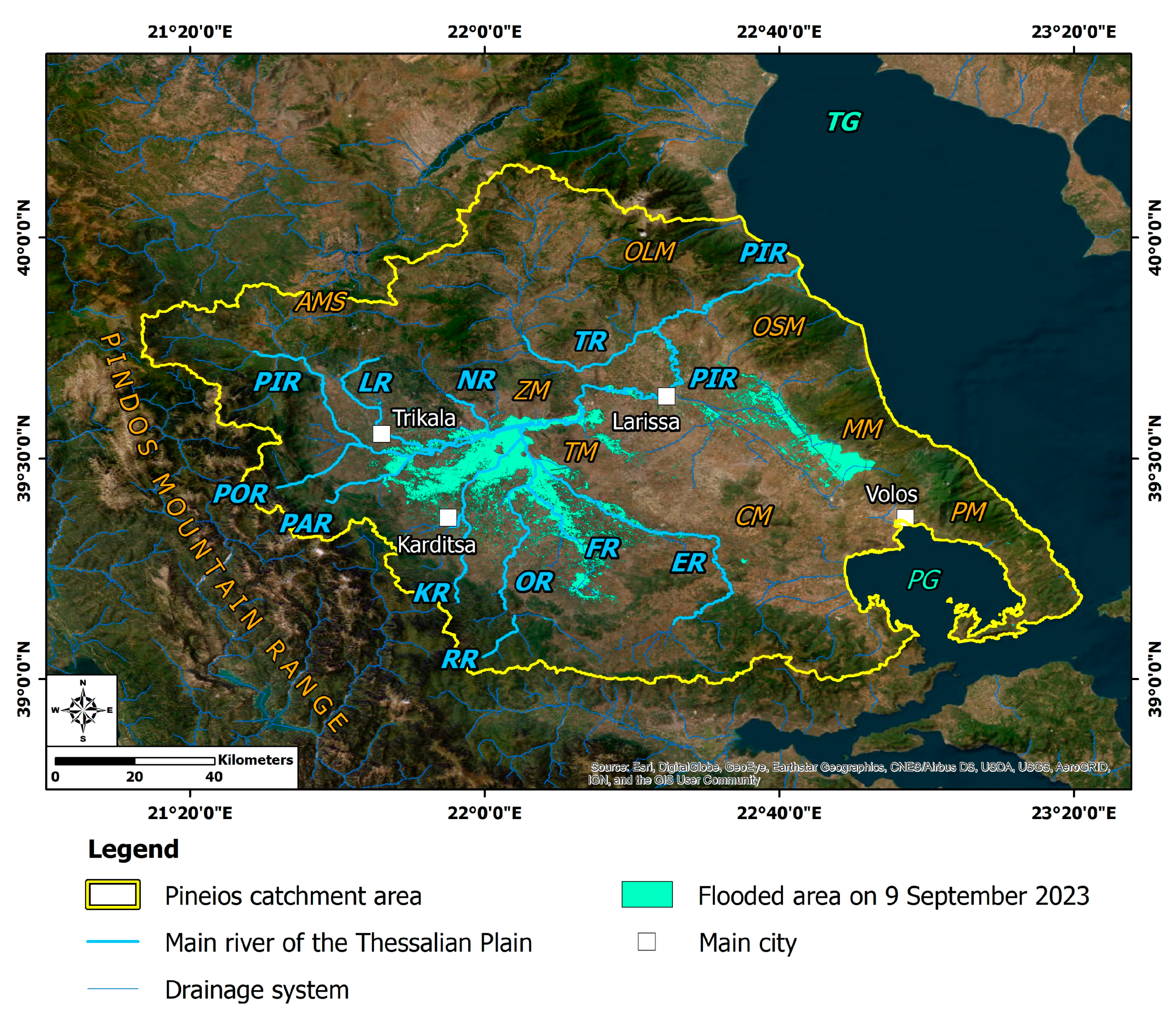

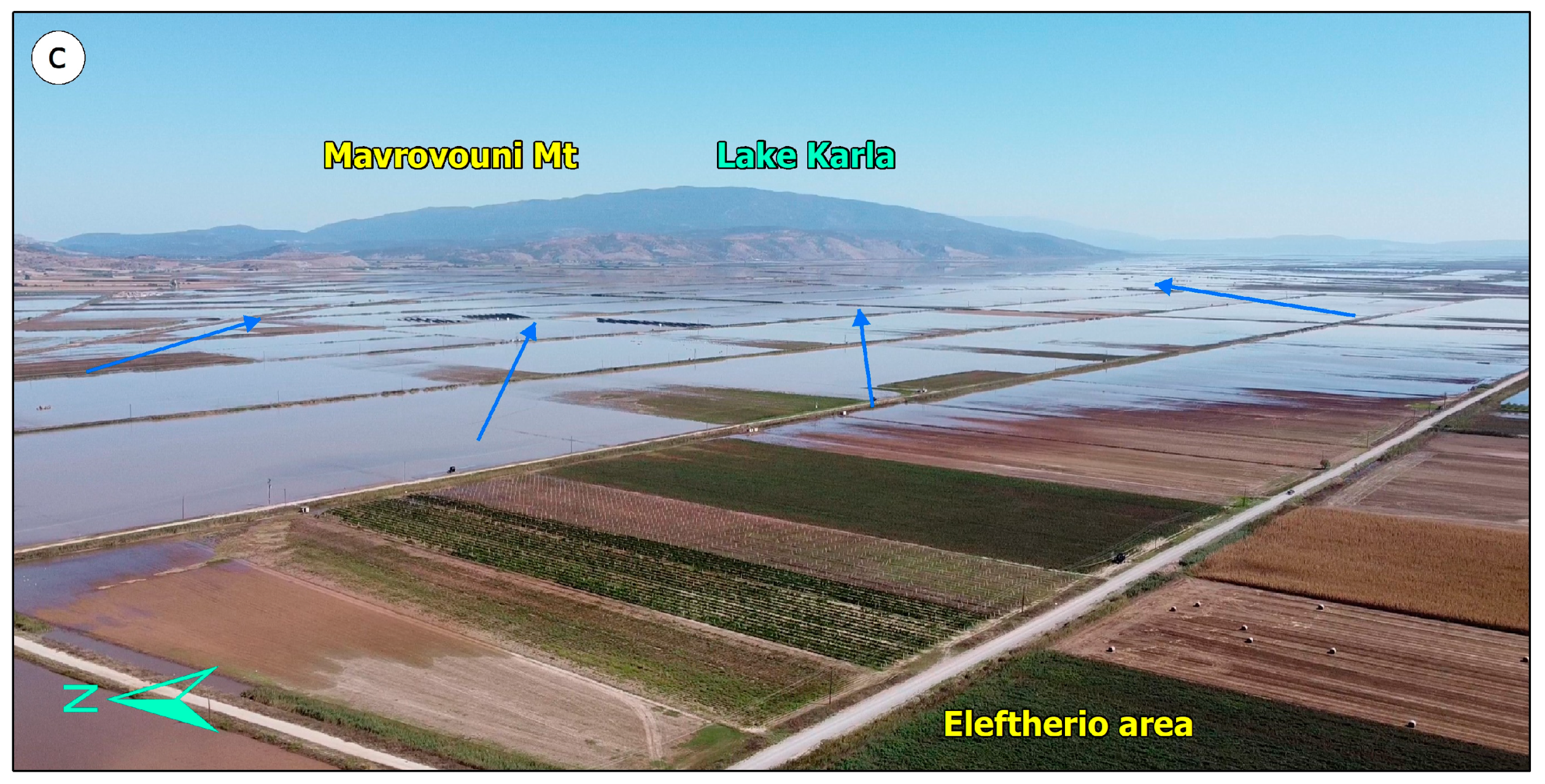

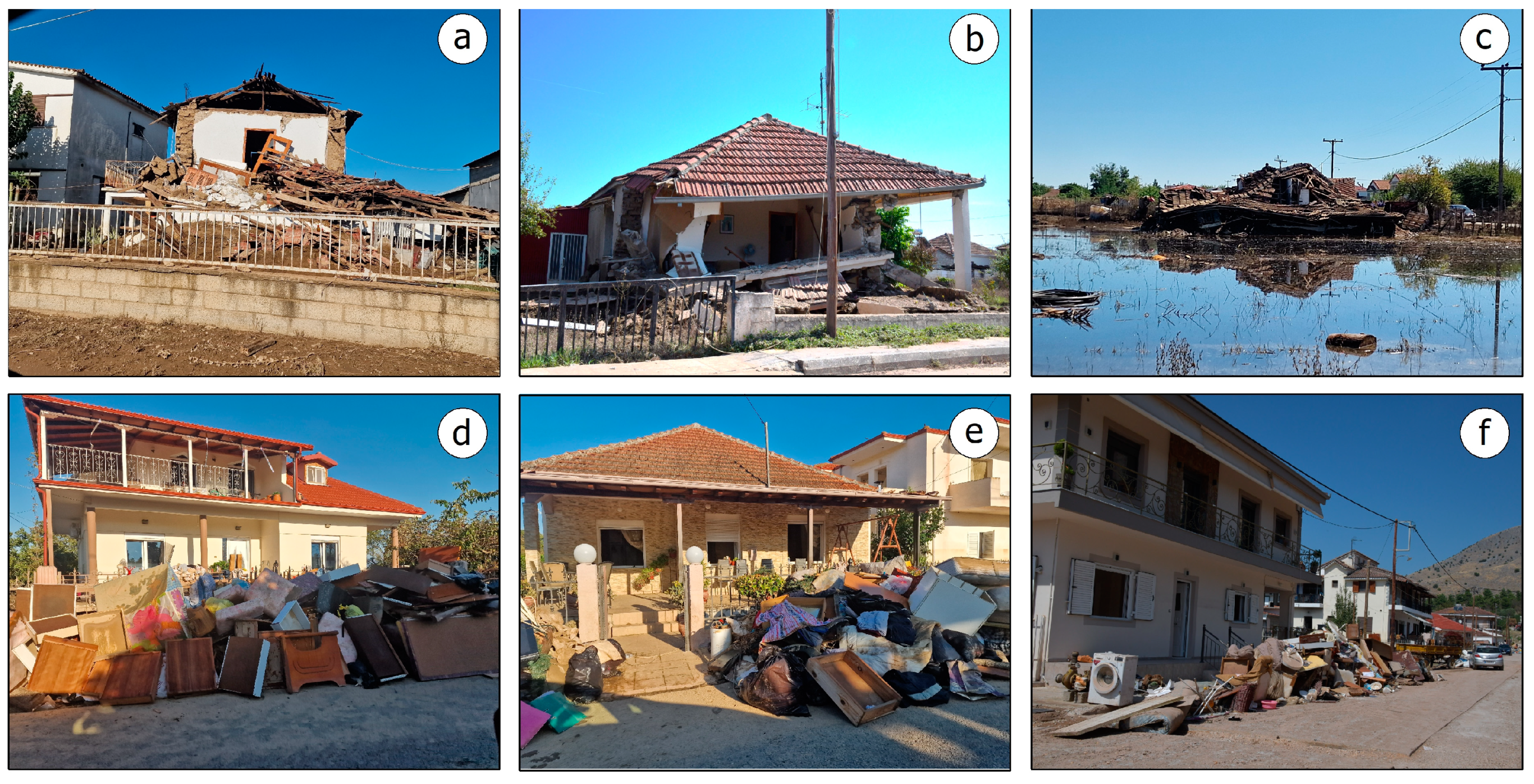
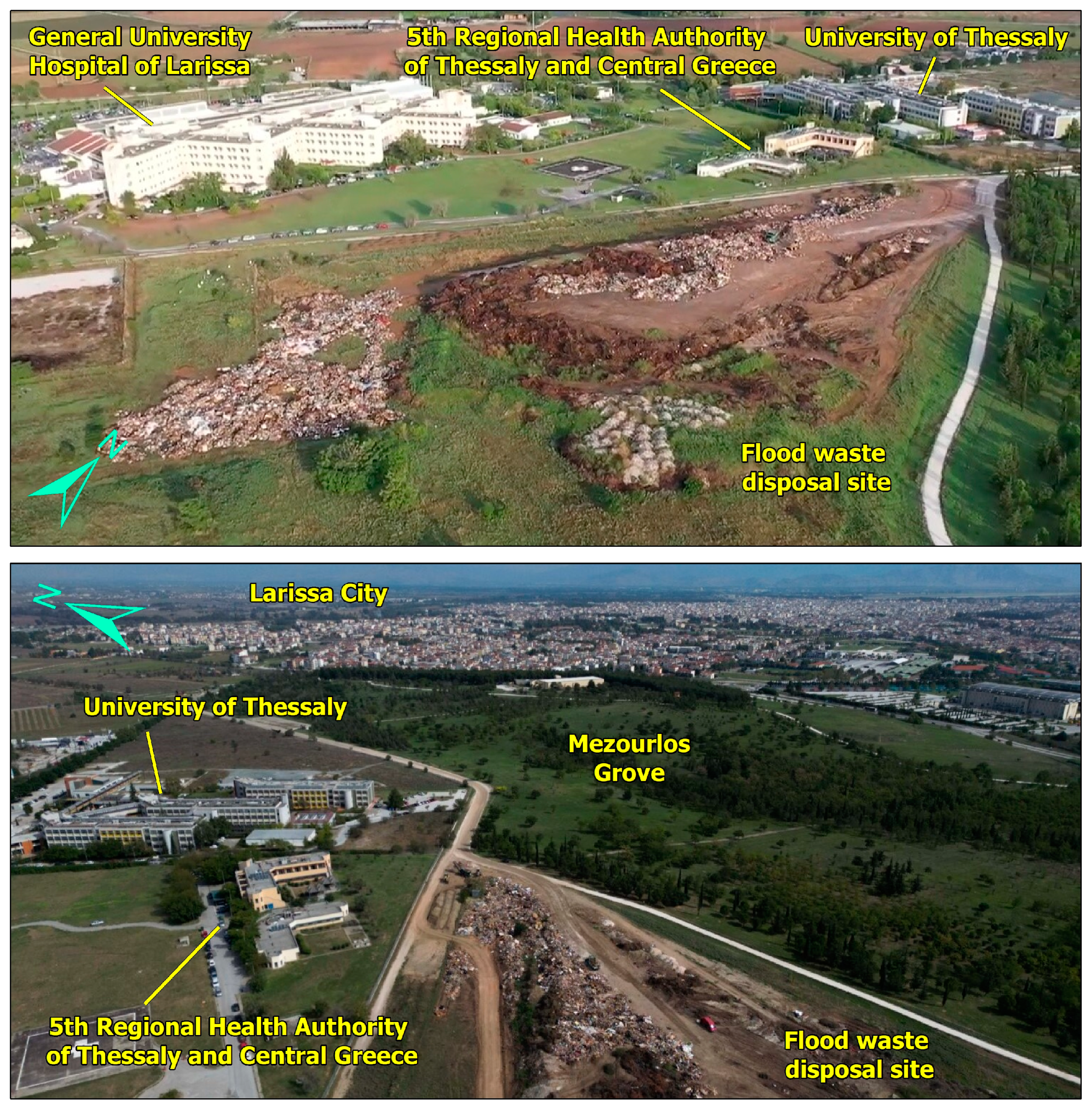

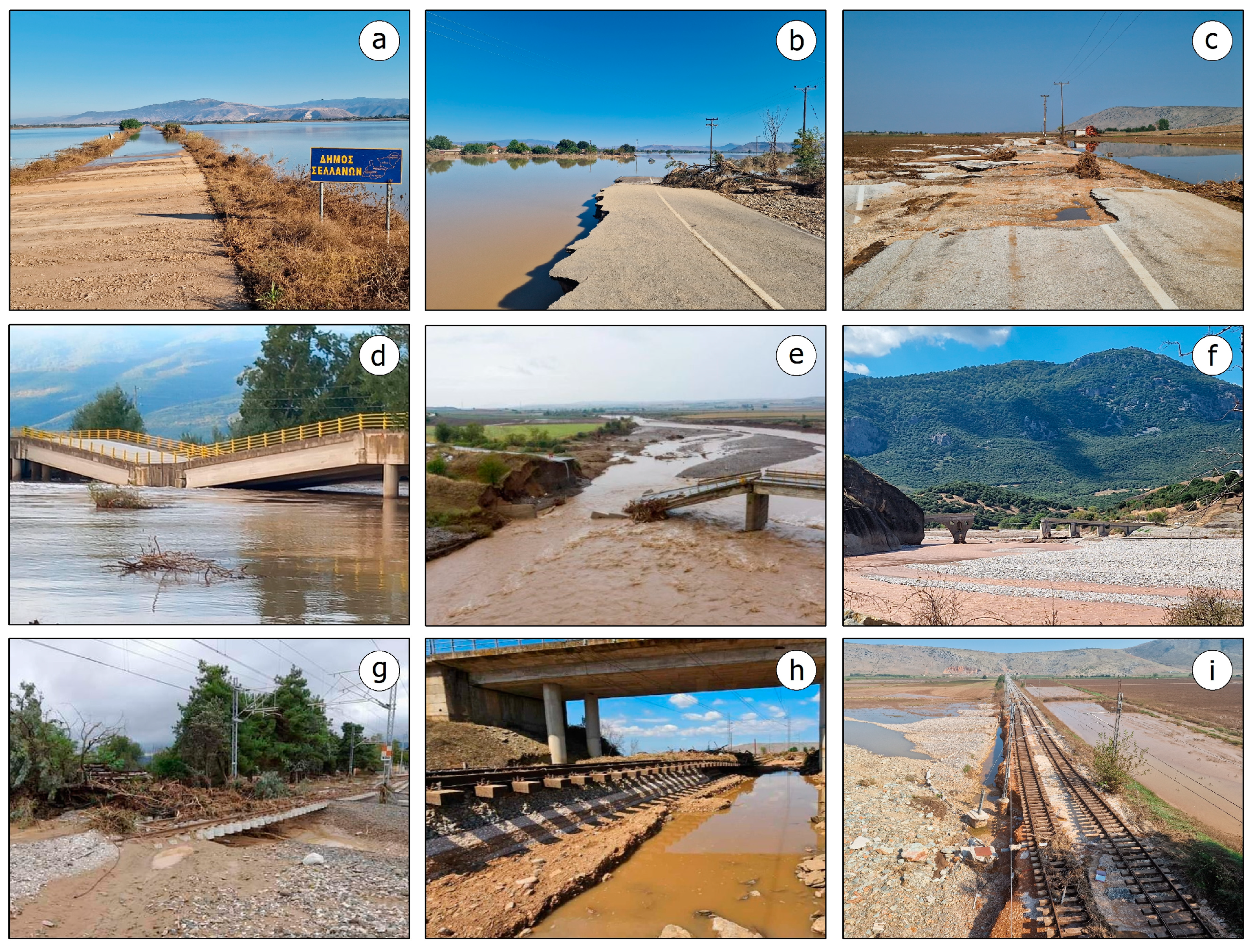
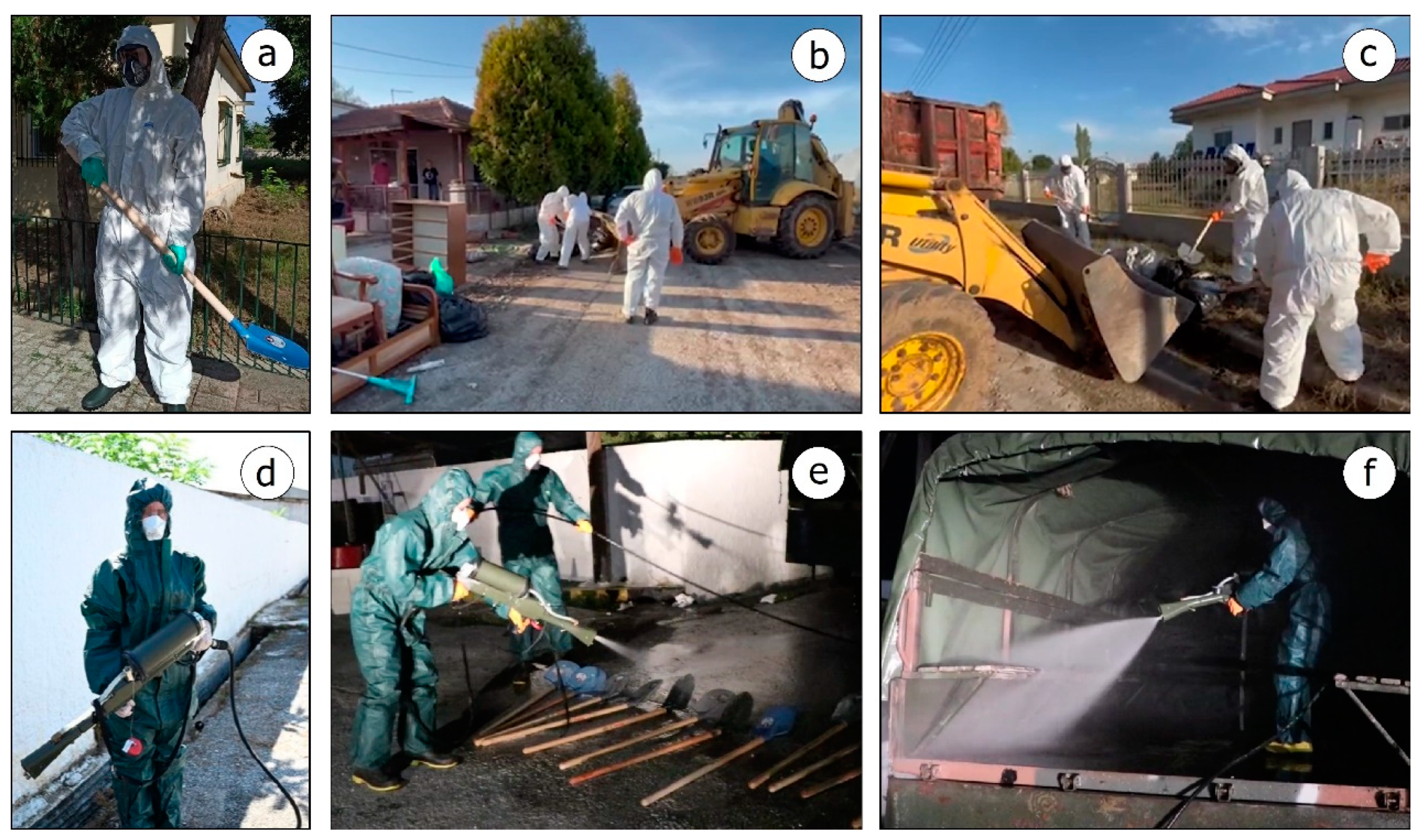
| Main Categories of Flood Waste | Elements of Flood Waste |
|---|---|
| Green waste | Fallen trees, soil, agriculture products, farms, and timbers. |
| Building rubble | Timber, wood chips, waste wood (such as column, and beam wall-material), bulky items, cables, concrete/bricks, steel, rebar, and aluminum material. |
| Household waste | Food waste, waste mixed with fibers, paper, wood chips, packaging materials, household furnishing and belongings, and other waste (such as plastics, cardboard, and paper). Daily waste discharged from the households. |
| Mixed waste | Mixed waste consisting of a small amount of concrete, wood chips, plastics, glass, soil, and sand. |
| Electrical appliances | Televisions, washing machines, and air conditioners discharged from affected houses, which are damaged by disasters and become unusable. |
| Automobiles | Vehicles, motorcycles, and bicycles that are damaged by disasters and cannot be used. |
| Vessels | An unusable ship damaged by a disaster. |
| Waste difficult to treat properly | Dangerous goods, such as fire extinguishers, cylinders, and items which are difficult to treat at local government facilities, such as pianos and mattresses (including radiation sources for non-destructive inspection), fishing nets, and gypsum boards. |
| Hazardous waste | Hydrocarbons, such as oil and fuel, paint, varnishes and solvents; pesticides and fertilizers; medical waste in debris; waste posing health care risks; asbestos-containing waste; PCB; infectious waste; chemical substances; toxic substances, such as chlorofluorocarbons, CCA (waste using chromium copper arsenic wood preservative), and tetrachloroethylene; pharmaceuticals; pesticides; hazardous waste; solar panels; and accumulators. |
| Mementos waste | Photos, albums, cash, and precious items. |
| Industrial waste, commercial waste | Food waste, raw materials, fertilizers, machinery, equipment, and shop-specific waste. |
| Waste from evacuation centers | Waste from relief camps and evacuation centers. |
| Excreta | Waste from temporary toilets fixed to facilitate water sanitation and hygiene. |
Disclaimer/Publisher’s Note: The statements, opinions and data contained in all publications are solely those of the individual author(s) and contributor(s) and not of MDPI and/or the editor(s). MDPI and/or the editor(s) disclaim responsibility for any injury to people or property resulting from any ideas, methods, instructions or products referred to in the content. |
© 2024 by the authors. Licensee MDPI, Basel, Switzerland. This article is an open access article distributed under the terms and conditions of the Creative Commons Attribution (CC BY) license (https://creativecommons.org/licenses/by/4.0/).
Share and Cite
Mavroulis, S.; Mavrouli, M.; Lekkas, E.; Tsakris, A. Impact of the September 2023 Storm Daniel and Subsequent Flooding in Thessaly (Greece) on the Natural and Built Environment and on Infectious Disease Emergence. Environments 2024, 11, 163. https://doi.org/10.3390/environments11080163
Mavroulis S, Mavrouli M, Lekkas E, Tsakris A. Impact of the September 2023 Storm Daniel and Subsequent Flooding in Thessaly (Greece) on the Natural and Built Environment and on Infectious Disease Emergence. Environments. 2024; 11(8):163. https://doi.org/10.3390/environments11080163
Chicago/Turabian StyleMavroulis, Spyridon, Maria Mavrouli, Efthymios Lekkas, and Athanasios Tsakris. 2024. "Impact of the September 2023 Storm Daniel and Subsequent Flooding in Thessaly (Greece) on the Natural and Built Environment and on Infectious Disease Emergence" Environments 11, no. 8: 163. https://doi.org/10.3390/environments11080163






